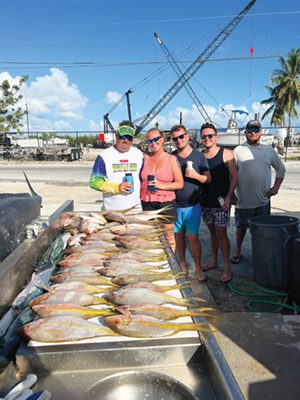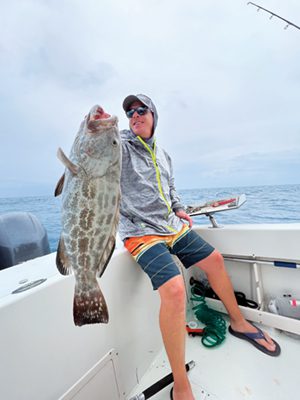 Winter Charters
Winter Charters
By: Capt. Joel Brandenburg
We charter offshore, deep sea, electric deep drop, big game, trolling in our 53ft or 45ft Hatteras and even our 30ft Grady White for mahi, tuna, wahoo, swordfish, sailfish, marlin, snowy grouper, tile fish, queen snapper, wreck fish and many other species. We also offer flats fishing, back country, sight fishing, fly fishing, light tackle, in our 24ft Proline Flatback or our 17ft Mako flats boat for bonefish, permit, pompano, snook, tarpon, redfish and many other species. We also offer a third option which is the reef and wreck fishing either anchoring and chumming or drifting over reef or wrecks typically in our 25ft Dusky or our 30ft Grady White targeting several species of snapper, grouper, mackerel and even African pompano, permit and cobia. During the winter months we do a lot of reef and wreck because many days it’s to windy and/or wavey to go offshore and the flats and back country is too murky and stirred up to do any sight fishing. A typical day of reef and wreck fishing would be heading out about 7 miles from Ana Banana Marina near Vaca Cut in Marathon Florida Keys. We head out straight south and anchor on the largest living reef in the world near Sombrero light house. Depending on where the best bite is, we’ll anchor as shallow as 20ft and as deep as 100ft. We do best between 70ft and 85ft. We anchor with a claw anchor rigged with zip ties to the chain so when we go to pull it up and when the anchor gets stuck in the reef the anchor will trip and reverse out and not damage our precious reef. We also pull it up with a ball and ring which saves my first mates back too. Once we are anchored, the first thing we do is evaluate the wind and drift current. Some days the chum flows to the left or right or center behind the boat. Any of those drifts are great and best for fishing, bottom dropping, flat lining or balloon free lining, etc. Unfortunately, sometimes the wind and drift current collide and come together head-to-head.

We use squid, ballyhoo, shrimp, pilchards, glass minnows, bonita belly, mullet gizzards, chicken gizzards, chicken hearts and many other baits. It’s good to travel out with several bait options. Yellowtail could have loved squid yesterday, but today they like mullet gizzards and tomorrow they might like shrimp only, yellowtail are very finicky creatures. When the tide goes slack, we like to pull anchor and drift wrecks in 100ft to 300ft deep. The reason we like to drift fish wrecks during slack or slackish tide is because it makes it a lot easier to keep our lines straight up and down. Our favorite bait is live bait. Many times, ballyhoo will school in our chum line on the reef, and we’ll cast net them or Bally hoop them and bring them out to drop and drift the wrecks and also free line some out on top. I could write a lot more about reef and wreck, but Phil only gives me 600 words..lol!
— For a charter with Captain Joel or Jojo Brandenburg of
Ana Banana Fishing Company in Marathon Florida Keys call cell
813-267-4401 or office 305-395-4212 or visit
www.marathonkeyfishingcharters.com or visit us in person at
Ana Banana Marina located at 11699 Overseas Hwy Marathon Florida Keys. Look for the big yellow Ana Banana sign with antlers around it.

 Winter Charters
Winter Charters